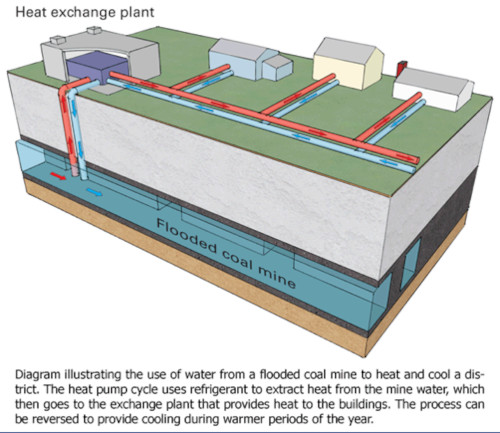Extracting heat from mines
Dr Pam Dugdale
I have always been interested in renewable energy, and just before starting my Permaculture Design Course I completed a Masters' degree in Sustainable Energy Solutions via distance learning at the University of the Highlands and Islands. During this time, I learnt a lot about the opportunities and challenges associated with providing low-carbon reliable energy, and also had the chance to complete some research. I found myself looking at two different research topics. The first, based on my job as a teacher, considered how best to embed sustainability into engineering and physical science education. The second was more technical, and looked at a sustainable alternative to gas boilers for heating homes. In this article I will focus on the latter (links to more information about both of the projects including full references are given at the end). In particular, I will briefly introduce a plan to provide community heat networks using warm water trapped in disused coal mines.
Throughout history, coal mines have been known to flood. This is because they fill up with water from underground streams and springs and constant seepage through porous subterranean rock. To prevent this, most operational mines are continuously pumped. When a coal mine is closed, the water pumps are turned off, and the mine floods. Miners working at the coal face often reported high temperatures that led to difficult working conditions. This heat comes from a combination of solar energy absorbed into the ground, and geothermal energy that originates from the formation of the planet, and from the natural decay of radioactive rock. Whilst unpleasant for the miners, the stored heat acts to increase the temperature of the flood water, which is something that we can use to our advantage. The basic principles of extracting heat from a disused coal mine are shown in Figure 1. Warm water from a flooded subterranean coal mine is pumped to a heat exchange plant above the ground. Heat energy is transferred from the mine water to either a domestic, industrial or district heating system.
 |
| Figure 1, Fundamental principles of extracting heat from a flooded coal mine |
 |
The heat exchange plant relies on devices called heat pumps. These use electricity to move thermal energy from a heat reservoir, in this case the warm mine water, to where it is needed, in this case a home. Since the amount of heat energy transferred from the thermal reservoir to the home is between 3 and 5 times the electrical energy used to operate the heat pump, the process is viewed favourably in terms of energy use and carbon emissions. If the electricity is sourced from renewable generation, the benefits are even greater.
The aim of my research was to investigate whether such a system could work in Wigan. In total there are 36 coal seams in the Wigan region. The deepest seam is the Arley seam, which is found at depths of around 1000m. All of the seams have been extensively mined, and are now abandoned and flooded. My work involved gathering historical data on the depth and temperature of Wigan mines and developing mathematical models to estimate the heat energy stored in each. Analysis showed that 40 MWth could be extracted from 11 local mines, with the most extensive thermal resource, in the South Hindley area, providing a potential 23.5 MWth from the Parsonage and Maypole mines alone, enough to heat over ten thousand homes.
So, in short, the answer is yes. Wigan, along with much of northern England and Scotland, has a proud history of coal mining, and is now sitting on a source of sustainable heat energy. This not only has the potential to provide low-carbon heating, with the appropriate levels of support and investment, but it is a genuine opportunity for these northern mining towns to build an innovative, community-based, and more equitable energy system, based on their industrial legacy.